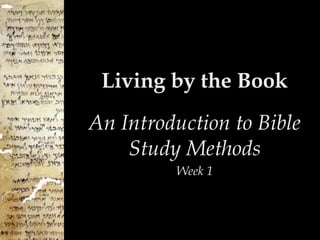Living by the Book Week 1
- 1. Living by the Book An Introduction to Bible Study Methods Week 1
- 3. What is the Bible? âĒ What are some views of the Bible? â Answer Book â Owners Manuel â Theological Text Book â Tool for Manipulation âĒ What are the issues that come with each of these views?
- 4. What is the Bible? The Bible is not a book for the faint of heart - it is a book full of all the greed and glory and violence and tenderness and sex and betrayal that benefits mankind. It is not the collection of pretty little anecdotes mouthed by pious little church mice - it does not so much nibble at our shoe leather as it cuts to the heart and splits the marrow from the bone. It does not give us answers fitted to our small-minded questions, but truth that goes beyond what we can even know to ask. from Thoughts and Reflections by Rich Mullins
- 5. What is the Bible? âĒ A working definition: A collection of writings containing the record and revelation of Godâs interaction with man.
- 6. Where are we going? âĒ Observation âĒ Interpretation âĒ Application âĒ Correlation
- 7. A collection of writingsâĶ âĒ Must begin with reading â Elementary Reading âĒ Rudiments of the art of reading âĒ Receives basic training in reading âĒ Acquires initial skills âĒ What does the sentence say? â Inspectional Reading âĒ Time is a key element at this stage âĒ Maximize involvement within given parameters âĒ What is this book about?
- 8. A collection of writingsâĶ âĒ Must begin with reading â Elementary Reading â Inspectional Reading â Analytical Reading âĒ More complex and systematic âĒ Ask organized and many questions âĒ Preeminently for the sake of understanding â Syntopical Reading âĒ Most complex and systematic âĒ Interacting with resources in relationship to another topic/idea/concept from How to Read a Book by Adler & Van Doren
- 9. Units of Thought Words Sentences Paragraphs Chapters Book
- 10. Observation Tools âĒ Reading Strategies â Thoughtfully â Repeatedly â Patiently â Selectively â Prayerfully â Imaginatively â Meditatively â Purposefully â Acquisitively â Telescopically
- 11. Observation Tools âĒ Reading Strategies âĒ Questions to Ponder â Who? â What? â Where? â When? â Why? â Wherefore?
- 12. Observation Tools âĒ Reading Strategies âĒ Questions to Ponder âĒ Grammar Structure â Verbs â Subject and Object â Modifiers â Prepositional Phrases â Connectives
- 13. Observation Tools âĒ Reading Strategies âĒ Questions to Ponder âĒ Grammar Structure âĒ Literary Structure â Biographical â Geographical â Historical â Chronological â Ideological
- 14. Observation Tools âĒ The Laws of Structure â Cause & Effect â Climax â Comparison â Contrast â Explanation or Reason â Interchange â Introduction & Summary â Pivot or Hinge â Proportion â Purpose â Question & Answer â Repetition â Specific to General; General to Specific
- 15. Observation Tools âĒ Reading Strategies âĒ Questions to Ponder âĒ Grammar Structure âĒ Literary Structure âĒ The Laws of Structure
- 16. Observation Tools âĒ Reading Strategies âĒ Questions to Ponder âĒ Grammar Structure âĒ Literary Structure âĒ The Laws of Structure âĒ Mile Markers â Emphasized â Repeated â Related â Alike â Unlike â True to Life
- 17. Observation Tools âĒ Reading Strategies âĒ Questions to Ponder âĒ Grammar Structure âĒ Literary Structure âĒ The Laws of Structure âĒ Mile Markers
- 18. Titus 3:-8 âĒ Take some time this week to practice observing âĒ Titus 3:3-8 and Titus 3:3-8 (remix) have been provided to allow you to take notes âĒ Consolidate questions âĒ Prioritize information âĒ Bring back 50 observations by next week
- 20. Next Week âĒ Observation âĒ Interpretation âĒ Application âĒ Correlation




















